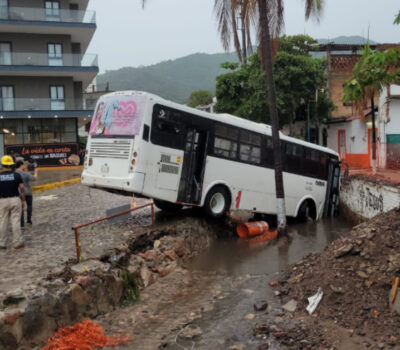The river rippled calmly in front of us, but we could hear the thunder of the rapids ahead.
“Everybody dowwwn!” our guide bellowed in his thick accent, a command to pull our paddles from the water and crouch onto the floor of our rubber raft.
No way we would stay upright on these rapids, I feared, thankful for the helmet strapped to my head. When I could finally see the swirling current, tumbling and slamming into boulders just ahead, I took a deep breath.
Waves of warm water washed over us. Our boat spun and ricocheted, sending us twirling between the tall pines and lush mountain jungle.
I couldn’t help but blurt out a squeal.
This was my kind of Mexico vacation.
I had always been tempted to try the popular seaside destinations that Minnesotans escape to each winter. Every time Facebook friends posted a palm-tree-laden photo on a subzero day in Minneapolis, I buried my jealousy under a down blanket.
But I remembered how I get bored lying on a beach for more than a few hours, and I recoiled at the thought of crowded, commercialized waterfronts. I imagined feeling trapped at a noisy all-inclusive resort.
Then along came Huatulco. Never heard of it? That’s probably because Huatulco (pronounced wah-TOOL-ko) is a somewhat new, less-developed tourist spot along Mexico’s southern Pacific Coast, in the state of Oaxaca. Most of its visitors are Mexicans, but the government’s tourism arm is working to draw international travelers.
Huatulco is made up of nine bays tucked between dramatic cliffs that drop into the sea. Along its 22 miles of coastline, the foothills of the Sierra Madre loom in the background. Before the government began promoting it for tourism in the 1980s, the area was populated only with fishing villages. Now it is marketing Huatulco as an eco-friendly destination and has vowed to preserve much of the rugged coastline, arid landscapes and green mountainsides.
Minnesota-based Sun Country Vacations started offering nonstop flights and packages there a couple of winters ago. On a subzero January morning, I was happy to board a plane with its nose pointed south, beach boredom be damned.
ADVENTURE AWAITS
Checking in at the open-air front desk of the Las Brisas resort a 4{-hour flight later, my husband and I quickly learned why Huatulco is a good-weather bet: Every sun-filled day hovered in the 90s during our stay. The coast sees only about 40 days of rain a year. “We call it rainy season because we have to call it something,” one guide joked.
Still, I cringed as a front-desk clerk strapped a bright blue, all-inclusive band onto my wrist. It would be my ticket to endless drinks and food, but it also felt like I was being tagged in a herd of livestock.
That worry receded after we headed out of our sleek room to see what the resort had to offer.
There were four different beaches, including a sports beach where we could use kayaks, stand-up paddle boards and catamarans as much as we wanted. “Hey!” I smiled as I said to my husband, “We can do this every day.”
Two beaches over, we could use resort snorkeling equipment to explore a reef just a few yards from shore. A rocky and secluded “secret beach” was tucked around a corner.
None of the beach views were obscured by high rises or billboards or neon lights. Huatulco was far less crowded and commercialized than I had expected.
And there were plenty of opportunities to get away from the resort. In the lobby, tour operators set up tables hawking day trips: White-water rafting, bicycling, scuba diving, fishing, ATV riding and bird-watching along with tours of coffee plantations, ancient ruins and a butterfly sanctuary.
Adventures were everywhere in Huatulco. In the seven days before our Sun Country flight would hurl us back to snow, we wouldn’t have enough time to do it all.
BEACHES
Huatulco’s nine dramatic ocean bays – its biggest draw – do not disappoint. For a fee, guided tours took tourists to remote bays, accessible only by boat, for snorkeling, diving or just watching the sunset.
Even on the busiest bays, activity on the water was light. Iguanas sunned themselves on seaside rocks as we launched a double kayak into ocean swells in Tangolunda Bay, among the most developed with resorts and some private homes.
Almost immediately, we felt immersed in nature: The shell of a large sea turtle bobbed in the distance. A pelican divebombed a fish in front of us. We circled small rock islands with waves crashing against them.
Nearer to shore, I tried riding the bay on a stand-up paddleboard. Swamped by a large wave, I splashed into refreshing water. Later, we set sail on a small catamaran, learning to pull the sails as we zigzagged across the surface.
Walking over to the snorkeling beach on the resort’s curving sidewalk, we passed one of the outdoor bars. We took a break for margaritas. Maybe an all-inclusive resort wasn’t so bad.
MOUNTAINS
As much as the blue waters and beige sand beckoned, I couldn’t help but look at the mountain foothills behind us.
Our guided rafting trip took us a couple of hours up the mountains to the Copalita River. Floating down, we gazed at dense wilderness between bouts of jitters, brought on by Class 4 rapids. The rafting trip only whetted my appetite for more mountain fun.
The brochure in our room touted hiking trips, but when I asked about them, the tour operators looked at me quizzically, as though I were the first to ever inquire about the offering.
“Alejandro on the beach,” one operator suggested, “he’s hyper. Maybe he’d take you.”
I searched the Web myself instead, and wound up contacting a Florida transplant who created the website huatulcoadventure.com.
George Hurchalla, a 47-year-old travel guide writer, met us at the Las Brisas lobby before dawn to take us on a mountain hike.
As his dusty Subaru climbed curvy roads, he couldn’t help but brag about the corner of paradise he called home: white-water rivers, amazing coral reefs, world-class surf breaks, great deep-sea fishing, a wide range of flora and fauna.
“I finally got friends to come visit, and they said, ‘Why didn’t you tell us it was like this?’ “ Hurchalla recalled them marveling. “I did. I tried. You just can’t understand it until you see it.”
Hurchalla turned his car onto a muddy, bumpy dirt road and stopped at a narrow walking path. The air was a crisp contrast to the heat of the coast. Hurchalla, who stands a thin 6 feet 7 inches tall, stretched out his long arms. “That’s the coolest breeze I’ve felt in a long time,” he said. The temperature almost begged for long sleeves. We stopped to soak in the unusual mixture of nature: tall pine trees, shade coffee plants, citrus.
There really is a mix of elements that allow the adventurer to soak in the atmosphere.
The river rippled calmly in front of us, but we could hear the thunder of the rapids ahead.
“Everybody dowwwn!” our guide bellowed in his . . .











